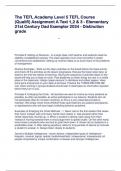The TEFL Academy Level 5 TEFL Course
(Qualifi) Assignment A Text 1,2 & 3 - Elementary
21st Century Dad Exemplar 2024 - Distinction
grade
Principle 8: Setting up Routines - In a large class, both teacher and students need the
stability of established routines. The class operates much more smoothly if certain
conventions are established. Setting up routines helps us to avoid many of the problems
of management.
Routine Examples - Write out the day's activities on the board before the class arrives
and check off the activities as the lesson progresses. Discuss the lesson plan daily, at
least for the first few weeks of teaching. Having the sequence of activities listed on the
board will help you to keep on track. Post deadlines on when things are due in a visible
place in the classroom. Assign 'paper persons' to distribute and collect papers. Have
extra pens and pencils on your desk at all times. Practice the 'THREE BEFORE ME'
rule: when working in groups students should ask 3 classmates an information question
before they turn to you.
Principle 9: Enlarging the Circle - As teachers we want to involve as many students as
possible, as often as possible, as active participants in our lessons. Students who do
not participate often do not learn anything, so this is a very essential principle to
maintain. We simply never know whether those quiet listeners are passive participants,
or daydreamers who will soon begin exhibiting behavior problems.
Examples of Enlarging the Circle Methods - 1. Never call on the first student that raises
their hand, instead, wait until many hands have raised. 2. Use physical rather than
verbal responses, thumbs up. 3. When a student is talking, back away from them
instead of moving towards them to encourage them to speak louder. On the other hand,
move close to students who are loud to quiet them down. 4. Never call on students in a
predictable order. 5. After asking questions, allow for long periods of silence to motivate
a student to answer. 6. Always listen closely to students.
Garner's Multiple Intelligences - seven distinct, independent types of intelligence--
linguistic, musical, logical, spatial, bodily/kinesthetic, intrapersonal, interpersonal; all
people comprised by unique combination of weaker and stronger intelligences.
, Verbal/Linguistic Intelligence - The ability to use language masterfully to express
oneself rhetorically or poetically. Also allows one to use language as a means of
remember information. Students of this intelligence like to write papers and letters, learn
through reading, need to see words before remembering them, enjoy stories, wordplay.
Body/Kinesthetic Intelligence - The ability to use physical movement and the knowledge
of body, including the brains motor cortex, which controls bodily motion, to solve
problems using body. (dance, gymnastics, sports, etc): Students of this intelligence
learn through movements, dance, and physical manipulation, and they must connect
language to physical activities.
Logical-Mathematical Intelligence - The ability to detect patterns, reason deductively
and think logically. Most often associated with scientific and mathematical thinking.
Students of this intelligence are good with numbers and logic, and they learn through
solving puzzles and solving problems. They like to know expectations and explainations
in terms of rules, routines, and assignments, they like to read about new developments
in science.
Musical/Rhythmic Intelligence - The ability to read, understand, and compose musical
pitches, tones, and rhythms. Auditory functions are required for a person to develop this
intelligence for pitch and tone, but it is not needed for the knowledge of rhythm.
Students of this intelligence like to sing, play a musical instrument, and listen to music.
They learn the sounds and rhymes of language through songs and chants, and they
may have an easy time mastering stress and intonation.
Visual/Spatial Intelligence - The ability to manipulate and create mental images in order
to solve problems. Not limited to visual sight, Gardner noted that blind children can
possess this. Students of this intelligence like to take photographs and draw pictures.
They have a good spacial sense, and can find their way around easily. They learn
through visual aids, charts, and graphs.
Intrapersonal Intelligence - The ability to understand and regulate your own emotions
involves sensitivity to and understanding of own desires, fears, intentions, and
capacities. (insightful, spiritual, sympathetic): Students of this intelligence like to reflect,
meditate, and keep a journal. They prefer to use their own methods of studying and
mastering new material. They learn through reflection, independent work, and using
their own learning strategies.
Interpersonal Intelligence - The ability to connect with others via empathy and recognize
distinctions among people so as to appreciate their perspectives with sensitivity to their
motives, moods and intentions. (political, leadership, public relations, etc.): Students of
this intelligence prefer doing things with other people, instead being alone. They solve
problems by discussing them with friends, and learn best through interaction with
others, discussions, and group work.




